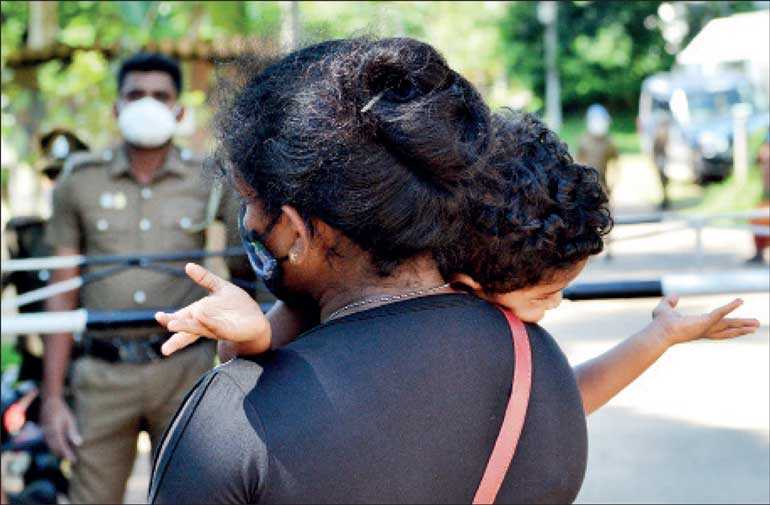Sunday Apr 20, 2025
Sunday Apr 20, 2025
Friday, 11 December 2020 00:00 - - {{hitsCtrl.values.hits}}

Many days after the incident, the distraught relatives were left in a state of uncertainty not knowing if it was their relative who had been killed or injured. All they wanted, as they stood at the gates for days, was simply to know either way – Pic by Shehan Gunasekara
“And when did we see you sick or in prison and visit you?” – Mathew 25:39
Mothers, wives and perhaps sisters and daughters, desperate for news and equally fearful of what they  might hear, unable to control their grief but courageously confronting the authorities, standing in the way of a police car and banging on it with their fists, brave but in despair, wanted only one thing. Information.
might hear, unable to control their grief but courageously confronting the authorities, standing in the way of a police car and banging on it with their fists, brave but in despair, wanted only one thing. Information.
In the past few days, the media has reported the deaths of 11 and injuries to over 50 inmates due to the recent clashes between protesting prisoners at the Mahara Prison and the law enforcement authorities. It is not a piece of news that one casually passes by. Deaths, even of those not usually in the public consciousness, when it occurs while in the custody of the state, alerts everyone in society to a significant problem.
This was no ordinary prison riot. It was a desperate call by imprisoned men in fear for their lives as the Government transferred COVID-19 infected prisoners from Welikada Prison to Mahara, an overcrowded facility where most of the dead and injured from the subsequent violence were found to be on remand for bailable offences.
The Human Rights Commission of Sri Lanka has already informed the Government that “If the authorities had responded to prison officials’ concerns to this proposed transfer and had, instead, set up a separate treatment facility for prisoners, this clash and the subsequent deaths could have been completely avoided. There is absence of clarity on treating new admissions leaving long delays in PCR testing.”
Yet again, COVID-19 has brought to the fore, long unaddressed issues in the affairs of the state, as it has done in the case of individuals, lying buried under the daily grind.
The Human Rights Commission of Sri Lanka visited the prison on 30 November and 1 December “to ascertain the nature of the incidents that occurred since 29 November 2020”. It started its own inquiries following the reports in the media in furtherance of its mandate under HRCSL Act No. 21 of 1996. The Commission had received several calls from the families of the inmates and subsequently, from the remandees themselves. Based on their findings the Commission proposed urgent interim recommendations in a report issued on the 2nd of December to the Commissioner General of Prisons, the Chief Justice, Attorney General, Inspector General of Police, Minister of Prison Reforms and Director General of Health Services.
The report states: “As of 4 p.m., 30 November, the authorities were unable to confirm to the HRCSL the details of the people who had died, the injured who had been transferred to Ragama Hospital or the prisoners who had been granted bail. This means anxious family members are unable to determine the fate of their loved ones. This must be rectified at once.”
How is it possible to measure a mother’s grief, a wife’s anxiety and a daughter’s fear that their loved one may have been killed or seriously injured? Does it make any difference that their relative had been accused of a crime and were awaiting trial? 80% of those who died and were injured, it was reported, had not been brought to trial.
Many days after the incident, the distraught relatives were left in a state of uncertainty not knowing if it was their relative who had been killed or injured. All they wanted, as they stood at the gates for days, was simply to know either way.
There has not been a convincing explanation thus far by the Government as to how so many prisoners ended up being killed and injured. The grief of the relatives was further compounded by the unconvincing explanation by the Government that the prisoners killed and injured each other. The CCTV footage that the authorities released to the public as evidence, instead shows prison guards laughing and standing by as a few prisoners got into an altercation.
What it resulted in was the observation by the Human Rights Commission in their interim report that “prison officials were in urgent need of training on how to manage this type of situation”. It didn’t bear out the Government’s intended message that the prisoners had murderously turned on each other.
Apart from their legitimate fear that the prisoners may contract COVID-19, confined as they are and at the mercy of the State to ensure the conditions of their existence, their relatives have now had to endure the knowledge that those incarcerated could not be assured of their safety while in prison.
What was also made clear was the lack of a structure and process which deprived the communication of even the most basic information as to the identity of the dead and injured to the relatives. One of the recommendations of the HRCSL, i.e., “Create a centralised register of remandees to avoid the current problem in Mahara” should perhaps have been self-evident before the riot, but obviously needed inclusion in their current report.
The Human Rights Commission made several recommendations for immediate implementation under the headings of Reducing the prison population, Health and treatment of prisoners, Releasing information and Welfare. It further made Short-, Medium-, and Long-term recommendations.
In a damning indictment of the state, in its Short-term recommendations, the first one reads as follows: “Lack of preparedness and decision-making structures: It was our observation that there was no centralised decision-making system responding to the situation. We recognise that unrest at a facility is difficult to manage because of the fear of the COVID-19 pandemic. However, it is essential that such a structure is set in place. This must include experts on crowd control, negotiation skills and advisors on minimum force. Had such a structure existed, it is possible that most lives lost on 29/30 November could have been saved.”
Many of us who hardly ever spend time wondering about the conditions of prisoners, yet assume that certain basic human rights, which even those biblically described as “the least of us” such as prisoners, are surely observed.
Others who saw no useful role for the Human Rights Commission would fully appreciate its intervention seeing the sheer pathos of a wailing mother asking an officer of the law who brusquely asked her to go home because there was no information to give her, what use it would be for her to go home, when she didn’t know if her son was alive or dead.
Yet others, who view the UN Human Rights Council with hostility and would rather leave it, will find that a multilateral organisation consisting of UN member states, would hardly be deterred by such loss, to continue its mandated tasks of encouraging states to protect the human rights of all its citizens.
It would be no surprise if next year, at the highest profile of all sessions of the UN Human Rights Council in Geneva, the March session, Sri Lanka comes up yet again, not only because of the promised revisiting of Resolution 30/1, but because the State messed up at the Mahara prison. We cannot blame the usual suspects, the international community, the NGOs, etc., because the State failed to respond appropriately to human beings in mortal fear of coming into close contact with confirmed COVID-19 patients while being confined behind bars with nowhere to run.
Until we were all shocked into forced confrontation of it with graphic visuals in the media, only the mothers, wives, sisters, daughters, understood their desperation. It is absolutely imperative that the Government responds fast to the recommendations of the Human Rights Commission of Sri Lanka. It will not be a great idea to instead reply to the inevitable queries in Geneva with the “Reverse Pill” theory, nor blame the victims for sudden, uncontrollable, murderous intentions towards their fellow inmates.
It is wiser to address and be seen to address, the systemic inadequacies of the process of management of prisons, which has been helpfully detailed by our own Human Rights Commission, which is to shortly hand over to the Government its final report. This will also reassure Sri Lanka’s own citizens including its prison population, and bring some comfort to those who mourn the dead and injured in Mahara.
“Truly, I say to you, as you did not do it to one of the least of these, you did not do it to me” – Mathew, 35:45.
Discover Kapruka, the leading online shopping platform in Sri Lanka, where you can conveniently send Gifts and Flowers to your loved ones for any event including Valentine ’s Day. Explore a wide range of popular Shopping Categories on Kapruka, including Toys, Groceries, Electronics, Birthday Cakes, Fruits, Chocolates, Flower Bouquets, Clothing, Watches, Lingerie, Gift Sets and Jewellery. Also if you’re interested in selling with Kapruka, Partner Central by Kapruka is the best solution to start with. Moreover, through Kapruka Global Shop, you can also enjoy the convenience of purchasing products from renowned platforms like Amazon and eBay and have them delivered to Sri Lanka.
Discover Kapruka, the leading online shopping platform in Sri Lanka, where you can conveniently send Gifts and Flowers to your loved ones for any event including Valentine ’s Day. Explore a wide range of popular Shopping Categories on Kapruka, including Toys, Groceries, Electronics, Birthday Cakes, Fruits, Chocolates, Flower Bouquets, Clothing, Watches, Lingerie, Gift Sets and Jewellery. Also if you’re interested in selling with Kapruka, Partner Central by Kapruka is the best solution to start with. Moreover, through Kapruka Global Shop, you can also enjoy the convenience of purchasing products from renowned platforms like Amazon and eBay and have them delivered to Sri Lanka.